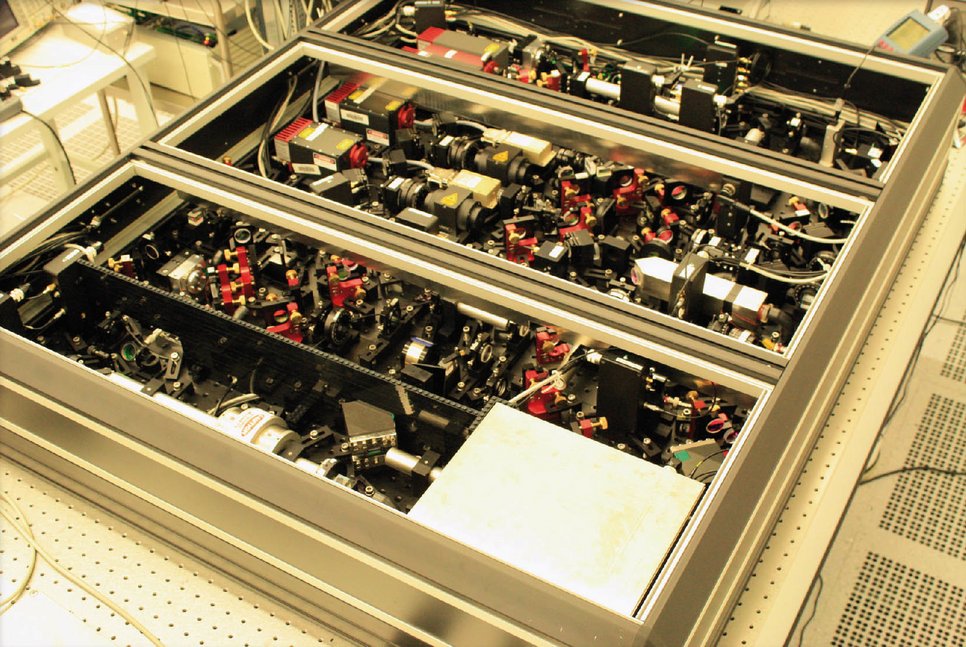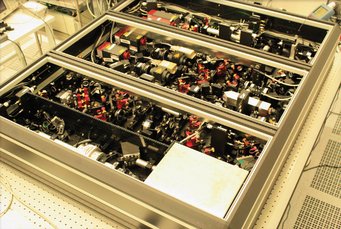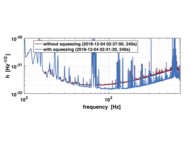Squeezing
The GEO600 squeezed light source.
© AEI Hannover
The GEO600 squeezed light source.
© AEI Hannover
The international network of gravitational-wave detectors has pushed the precision of its measurements so far that it is limited by the quantum nature of light itself. The laser beam used to measure the differential arm length in GEO600 is not truly continuous, but consists, as any light beam, of a large number of light particles (photons). The very nature of light itself implies that these photons are not arranged like a string of pearls but are travelling in irregular groups, and it is this grouping that creates noise in the gravitational wave measurement.
In 2010 GEO600 was the first gravitational wave detector to apply squeezed light injection to reduce this quantum noise and to this day GEO600 holds the world record in duration and strength of squeezed light used. The squeezed light source was developed and built at the Albert Einstein Institute, and currently the optimal application of squeezed light injection is a topic of ongoing research at GEO600, including:
the development of an automatic alignment system for squeezed light,
the development of a new control signal for squeezing angle detection, and
automated locking of the squeezed light source.
With all these techniques combined, the first long-term application of squeezed light at a GW detector has been achieved. Squeezing can typically be applied for more than 90% of the time, and we could show that squeezing is compatible with a low glitch rate of the h-channel.
German-British instrument mitigates quantum noise effects better than any gravitational-wave detector before
more
The German-British gravitational-wave detector makes a key step towards third-generation observatories like the Einstein Telescope
more
A quantum phenomenon allows detectors which sense oscillations of space-time to measure with 50 percent more accuracy.
more
The Virgo squeezer
The Virgo instrument has received a squeezer system based on the GEO600 design in 2018. The squeezer was built at the Max Planck Institute for Gravitational Phyics (Albert Einstein Institute) in Hannover.
The gravitational-wave observatory near Pisa listens deeper into the cosmos with technology from Hanover
more
Squeezed-light source developed at the Albert Einstein Institute to make Virgo even more sensitive to gravitational waves
more
Relevant publications
1.
Lough, J.; Schreiber, E.; Bergamin, F.; Grote, H.; Mehmet, M.; Vahlbruch, H.; Affeldt, C.; Brinkmann, M.; Bisht, A.; Kringel, V. et al. ; Lück, H.; Mukund, N.; Nadji, S. L.; Sorazu, B.; Strain, K.; Weinert, M.; Danzmann, K. : First demonstration of 6 dB quantum noise reduction in a kilometer scale gravitational wave observatory. Physical Review Letters
126 , 041102 (2021)
2.
Schreiber, E.; Dooley, K. L.; Vahlbruch, H.; Affeldt, C.; Bisht, A.; Leong, J.; Lough, J.; Prijatelj, M.; Slutsky, J.; Was, M. et al. ; Wittel, H.; Danzmann, K.; Grote, H. : Alignment sensing and control for squeezed vacuum states of light. Optics Express
24 (1), pp. 146 - 152 (2016)
3.
Dooley, K.; Schreiber, E.; Vahlbruch, H.; Affeldt, C.; Leong, J.; Wittel, H.; Grote, H. : 23 (7), pp. 8235 - 8245 (2015)
4.
Grote, H.; Danzmann, K.; Dooley, K. L.; Schnabel, R.; Slutsky, J.; Vahlbruch, H. : 110 , 181101 (2013)
5.
The LIGO Scientific Collaboration; Abadie, J.; Abbott, B. P.; Abbott, R.; Abbott, T. D.; Abernathy, M.; Adams, C.; Adhikari, R.; Affeldt, C.; Allen, B. et al. ; Allen, G. S.; Amador Ceron, E.; Amariutei, D.; Amin, R. S.; Anderson, S. B.; Anderson, W. G.; Arai, K.; Arain, M. A.; Araya, M. C.; Aston, S. M.; Atkinson, D.; Aufmuth, P.; Aulbert, C.; Aylott, B. E.; Babak, S.; Baker, P.; Ballmer, S.; Barker, D.; Barr, B.; Barriga, P.; Barsotti, L.; Barton, M. A.; Bartos, I.; Bassiri, R.; Bastarrika, M.; Batch, J.; Bauchrowitz, J.; Behnke, B.; Bell, A. S.; Belopolski, I.; Benacquista, M.; Berliner, J. M.; Bertolini, A.; Betzwieser, J.; Beveridge, N.; Beyersdorf, P. T.; Bilenko, I. A.; Billingsley, G.; Birch, J.; Biswas, R.; Black, E.; Blackburn, J. K.; Blackburn, L.; Blair, D.; Bland, B.; Bock, O.; Bodiya, T. P.; Bogan, C.; Bondarescu, R.; Bork, R.; Born, M.; Bose, S.; Brady, P. R.; Braginsky, V. B.; Brau, J. E.; Breyer, J.; Bridges, D. O.; Brinkmann, M.; Britzger, M.; Brooks, A. F.; Brown, D. A.; Brummitt, A.; Buonanno, A.; Burguet-Castell, J.; Burmeister, O.; Byer, R. L.; Cadonati, L.; Camp, J. B.; Campsie, P.; Cannizzo, J.; Cannon, K.; Cao, J.; Capano, C. D.; Caride, S.; Caudill, S.; Cavagliá, M.; Cepeda, C.; Chalermsongsak, T.; Chalkley, E.; Charlton, P.; Chelkowski, S.; Chen, Y.; Christensen, N.; Cho, H.; Chua, S. S. Y.; Chung, S.; Chung, C. T. Y.; Ciani, G.; Clara, F.; Clark, D. E.; Clark, J.; Clayton, J. H.; Conte, R.; Cook, D.; Corbitt, T. R.; Cordier, M.; Cornish, N.; Corsi, A.; Costa, C. A.; Coughlin, M.; Couvares, P.; Coward, D. M.; Coyne, D. C.; Creighton, J. D. E.; Creighton, T. D.; Cruise, A. M.; Cumming, A.; Cunningham, L.; Cutler, R. M.; Dahl, K.; Danilishin, S. L.; Dannenberg, R.; Danzmann, K.; Daudert, B.; Daveloza, H.; Davies, G.; Daw, E. J.; Dayanga, T.; DeBra, D.; Degallaix, J.; Dent, T.; Dergachev, V.; DeRosa, R.; DeSalvo, R.; Dhurandhar, S.; DiGuglielmo, J.; Di Palma, I.; Díaz, M.; Donovan, F.; Dooley, K. L.; Dorsher, S.; Drever, R. W. P.; Driggers, J. C.; Du, Z.; Dumas, J.-C.; Dwyer, S.; Eberle, T.; Edgar, M.; Edwards, M.; Effler, A.; Ehrens, P.; Engel, R.; Etzel, T.; Evans, K.; Evans, M.; Evans, T.; Factourovich, M.; Fairhurst, S.; Fan, Y.; Farr, B. F.; Farr, W.; Fazi, D.; Fehrmann, H.; Feldbaum, D.; Finn, L. S.; Fisher, R. P.; Flanigan, M.; Foley, S.; Forsi, E.; Fotopoulos, N.; Frede, M.; Frei, M.; Frei, Z.; Freise, A.; Frey, R.; Fricke, T. T.; Friedrich, D.; Fritschel, P.; Frolov, V. V.; Fulda, P. J.; Fyffe, M.; Ganija, M. R.; Garcia, J.; Garofoli, J. A.; Geng, R.; Gergely, L. Á.; Gholami, I.; Ghosh, S.; Giaime, J. A.; Giampanis, S.; Giardina, K. D.; Gill, C.; Goetz, E.; Goggin, L. M.; González, G.; Gorodetsky, M. L.; Goßler, S.; Graef, C.; Grant, A.; Gras, S.; Gray, C.; Gray, N.; Greenhalgh, R. J. S.; Gretarsson, A. M.; Grosso, R.; Grote, H.; Grunewald, S.; Guido, C.; Gupta, R.; Gustafson, E. K.; Gustafson, R.; Ha, T.; Hage, B.; Hallam, J. M.; Hammer, D.; Hammond, G.; Hanks, J.; Hanna, C.; Hanson, J.; Harms, J.; Harry, G. M.; Harry, I. W.; Harstad, E. D.; Hartman, M. T.; Haughian, K.; Hayama, K.; Heefner, J.; Heintze, M. C.; Hendry, M. A.; Heng, I. S.; Heptonstall, A. W.; Herrera, V.; Hewitson, M.; Hild, S.; Hoak, D.; Hodge, K. A.; Holt, K.; Hong, T.; Hooper, S.; Hosken, D. J.; Hough, J.; Howell, E. J.; Hughey, B.; Huynh-Dinh, T.; Husa, S.; Huttner, S. H.; Ingram, D. R.; Inta, R.; Isogai, T.; Ivanov, A.; Izumi, K.; Jacobson, M.; Jang, H.; Johnson, W. W.; Jones, D. I.; Jones, G.; Jones, R.; Ju, L.; Kalmus, P.; Kalogera, V.; Kamaretsos, I.; Kandhasamy, S.; Kang, G.; Kanner, J. B.; Katsavounidis, E.; Katzman, W.; Kaufer, H.; Kawabe, K.; Kawamura, S.; Kawazoe, F.; Kells, W.; Keppel, D.; Keresztes, Z.; Khalaidovski, A.; Khalili, F. Y.; Khazanov, E. A.; Kim, B.; Kim, C.; Kim, D.; Kim, H.; Kim, K.; Kim, N.; Kim, Y.-M.; King, P. J.; Kinsey, M.; Kinzel, D. L.; Kissel, J. S.; Klimenko, S.; Kokeyama, K.; Kondrashov, V.; Kopparapu, R.; Koranda, S.; Korth, W. Z.; Kozak, D.; Kringel, V.; Krishnamurthy, S.; Krishnan, B.; Kuehn, G.; Kumar, R.; Kwee, P.; Lam, P. K.; Landry, M.; Lang, M.; Lantz, B.; Lastzka, N.; Lawrie, C.; Lazzarini, A.; Leaci, P.; Lee, C. H.; Lee, H. M.; Leindecker, N.; Leong, J. R.; Leonor, I.; Li, J.; Lindquist, P. E.; Lockerbie, N. A.; Lodhia, D.; Lormand, M.; Luan, J.; Lubinski, M.; Lück, H.; Lundgren, A. P.; Macdonald, E.; Machenschalk, B.; MacInnis, M.; Macleod, D. M.; Mageswaran, M.; Mailand, K.; Mandel, I.; Mandic, V.; Marandi, A.; Márka, S.; Márka, Z.; Markosyan, A.; Maros, E.; Martin, I. W.; Martin, R. M.; Marx, J. N.; Mason, K.; Matichard, F.; Matone, L.; Matzner, R. A.; Mavalvala, N.; Mazzolo, G.; McCarthy, R.; McClelland, D. E.; McGuire, S. C.; McIntyre, G.; McIver, J.; McKechan, D. J. A.; Meadors, G. D.; Mehmet, M.; Meier, T.; Melatos, A.; Melissinos, A. C.; Mendell, G.; Menendez, D.; Mercer, R. A.; Meshkov, S.; Messenger, C.; Meyer, M. S.; Miao, H.; Miller, J.; Mitrofanov, V. P.; Mitselmakher, G.; Mittleman, R.; Miyakawa, O.; Moe, B.; Moesta, P.; Mohanty, S. D.; Moraru, D.; Moreno, G.; Mori, T.; Mossavi, K.; Mow-Lowry, C. M.; Mueller, C. L.; Mueller, G.; Mukherjee, S.; Mullavey, A.; Müller-Ebhardt, H.; Munch, J.; Murphy, D.; Murray, P. G.; Mytidis, A.; Nash, T.; Nawrodt, R.; Necula, V.; Nelson, J.; Newton, G.; Nishizawa, A.; Nolting, D.; Nuttall, L.; O’Dell, J.; O’Reilly, B.; O’Shaughnessy, R.; Ochsner, E.; Oelker, E.; Oh, J. J.; Oh, S. H.; Ogin, G. H.; Oldenburg, R. G.; Osthelder, C.; Ott, C. D.; Ottaway, D. J.; Ottens, R. S.; Overmier, H.; Owen, B. J.; Page, A.; Pan, Y.; Pankow, C.; Papa, M. A.; Ajith, P.; Patel, P.; Pedraza, M.; Peiris, P.; Pekowsky, L.; Penn, S.; Peralta, C.; Perreca, A.; Phelps, M.; Pickenpack, M.; Pinto, I. M.; Pitkin, M.; Pletsch, H.; Plissi, M. V.; Pöld, J.; Postiglione, F.; Predoi, V.; Price, L. R.; Prijatelj, M.; Principe, M.; Privitera, S.; Prix, R.; Prokhorov, L.; Puncken, O.; Quetschke, V.; Raab, F. J.; Radkins, H.; Raffai, P.; Rakhmanov, M.; Ramet, C. R.; Rankins, B.; Mohapatra, S. R. P.; Raymond, V.; Redwine, K.; Reed, C. M.; Reed, T.; Reid, S.; Reitze, D. H.; Riesen, R.; Riles, K.; Robertson, N. A.; Robinson, C.; Robinson, E. L.; Roddy, S.; Rodriguez, C.; Rodruck, M.; Rollins, J.; Romano, J. D.; Romie, J. H.; Röver, C.; Rowan, S.; Rüdiger, A.; Ryan, K.; Ryll, H.; Sainathan, P.; Sakosky, M.; Salemi, F.; Samblowski, A.; Sammut, L.; de la Jordana, L. S.; Sandberg, V.; Sankar, S.; Sannibale, V.; Santamaría, L.; Santiago-Prieto, I.; Santostasi, G.; Sathyaprakash, B. S.; Sato, S.; Saulson, P. R.; Savage, R. L.; Schilling, R.; Schlamminger, S.; Schnabel, R.; Schofield, R. M. S.; Schulz, B.; Schutz, B. F.; Schwinberg, P.; Scott, J.; Scott, S. M.; Searle, A. C.; Seifert, F.; Sellers, D.; Sengupta, A. S.; Sergeev, A.; Shaddock, D. A.; Shaltev, M.; Shapiro, B.; Shawhan, P.; Shoemaker, D. H.; Sibley, A.; Siemens, X.; Sigg, D.; Singer, A.; Singer, L.; Sintes, A. M.; Skelton, G.; Slagmolen, B. J. J.; Slutsky, J.; Smith, R. J. E.; Smith, J. R.; Smith, M. R.; Smith, N. D.; Somiya, K.; Sorazu, B.; Soto, J.; Speirits, F. C.; Stein, A. J.; Steinert, E.; Steinlechner, J.; Steinlechner, S.; Steplewski, S.; Stefszky, M.; Stochino, A.; Stone, R.; Strain, K. A.; Strigin, S.; Stroeer, A. S.; Stuver, A. L.; Summerscales, T. Z.; Sung, M.; Susmithan, S.; Sutton, P. J.; Talukder, D.; Tanner, D. B.; Tarabrin, S. P.; Taylor, J. R.; Taylor, R.; Thomas, P.; Thorne, K. A.; Thorne, K. S.; Thrane, E.; Thüring, A.; Titsler, C.; Tokmakov, K. V.; Torres, C.; Torrie, C. I.; Traylor, G.; Trias, M.; Tseng, K.; Ugolini, D.; Urbanek, K.; Vahlbruch, H.; Vallisneri, M.; van Veggel, A. A.; Vass, S.; Vaulin, R.; Vecchio, A.; Veitch, J.; Veitch, P. J.; Veltkamp, C.; Villar, A. E.; Vitale, S.; Vorvick, C.; Vyatchanin, S. P.; Wade, A.; Waldman, S. J.; Wallace, L.; Wan, Y.; Wanner, A.; Wang, X.; Wang, Z.; Ward, R. L.; Wei, P.; Weinert, M.; Weinstein, A. J.; Weiss, R.; Wen, L.; Wen, S.; Wessels, P.; West, M.; Westphal, T.; Wette, K.; Whelan, J. T.; Whitcomb, S. E.; White, D.; Whiting, B. F.; Wilkinson, C.; Willems, P. A.; Williams, H. R.; Williams, L.; Willke, B.; Winkelmann, L.; Winkler, W.; Wipf, C. C.; Wittel, H.; Wiseman, A. G.; Woan, G.; Wooley, R.; Worden, J.; Yablon, J.; Yakushin, I.; Yamamoto, K.; Yamamoto, H.; Yang, H.; Yeaton-Massey, D.; Yoshida, S.; Yu, P.; Zanolin, M.; Zhang, L.; Zhang, W.; Zhang, Z.; Zhao, C.; Zotov, N.; Zweizig, M. E.; Zucker, J. : A gravitational wave observatory operating beyond the quantum shot-noise limit. Nature Physics
7 , pp. 962 - 965 (2011)






